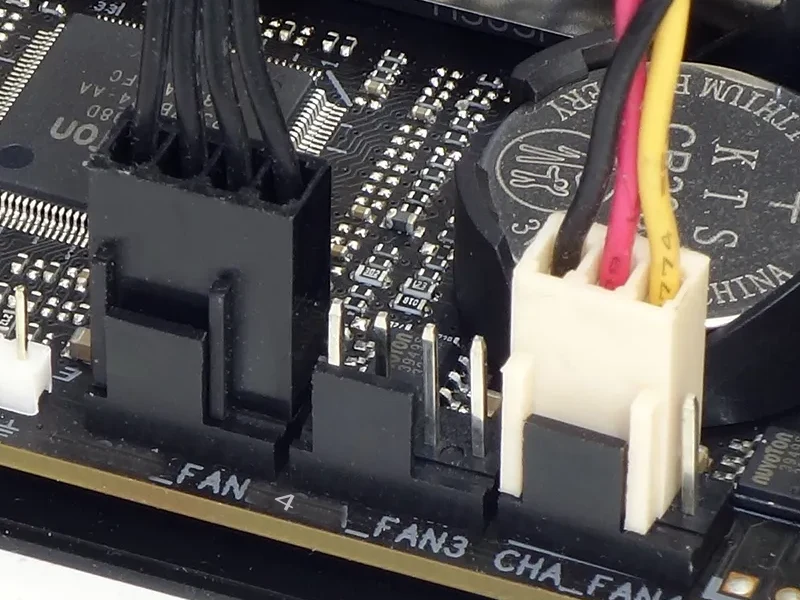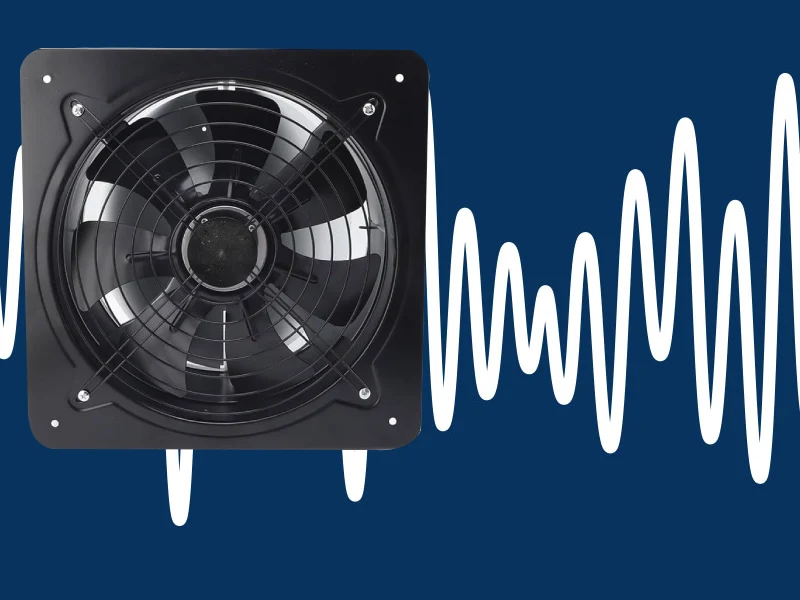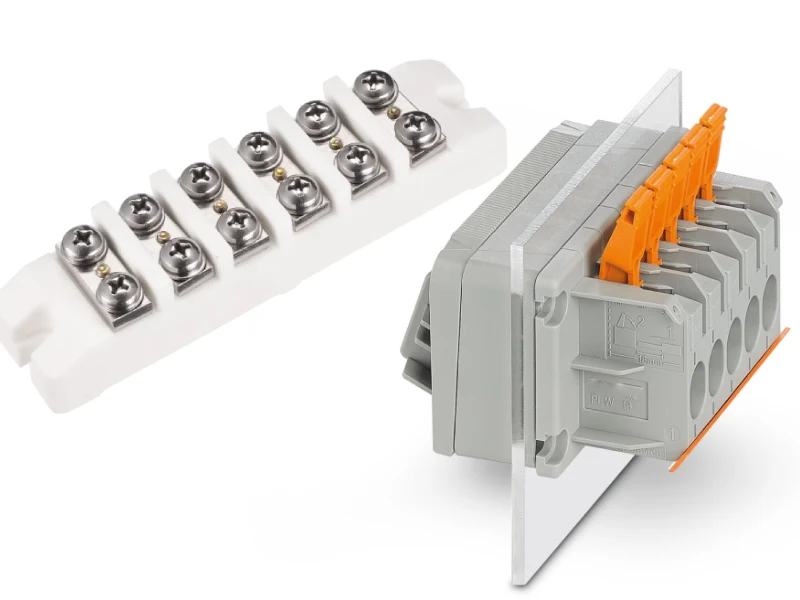Air-to-air heat exchangers move heat from one air stream to another. The two air streams do not mix together. This process uses heat recovery to save energy that would be lost. It helps keep the temperature steady in cooling systems. It also makes energy use better. In modern hvac, these devices are very important.
They can lower the energy needed to heat or cool outside air by up to 80 percent. Many uses, like electrical enclosure cooling or industrial automation, need air-to-air heat exchangers. They help protect equipment and support sustainability. These systems also help control contaminants. This makes them good for comfort and safety.
Air to Air Heat Exchanger Key Takeaways
- Air-to-air heat exchangers move heat between two air streams. This helps save energy and keeps the air clean.
- There are different types like plate exchangers, tube exchangers, thermal wheels, and energy recovery ventilators. Each type works for different needs and spaces.
- These systems help cool things like electrical enclosures, factories, data centers, and greenhouses. They also help lower energy costs.
- They cut energy bills by using heat that would be wasted. They keep air streams apart to stop contaminants. They need less care than regular HVAC systems.
- Picking air-to-air heat exchangers helps the environment. It protects equipment and makes indoor air better in many places.
How Air to Air Heat Exchanger Work
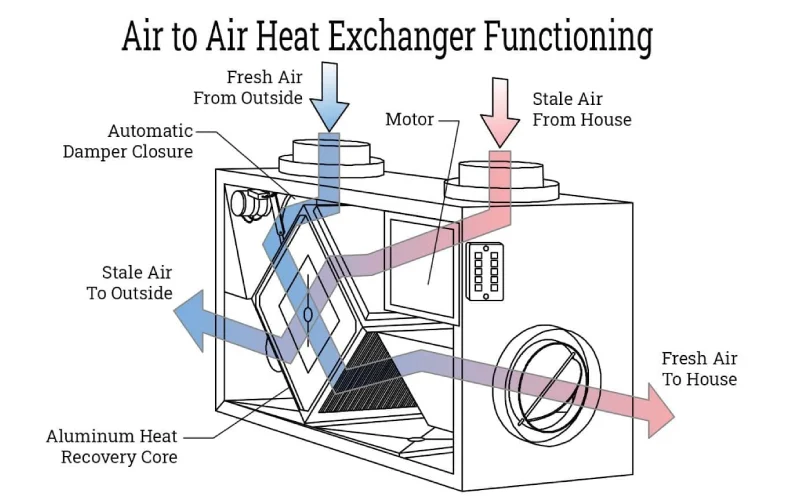
Heat Recovery Principle
Air-to-air heat exchangers use heat recovery to move energy between two air streams. The system takes heat from the warmer air and gives it to the cooler air. This helps keep the temperature inside buildings or enclosures steady. The heat recovery principle uses science to move energy and stop waste.
There are two main types of heat recovery systems: regenerative and recuperative. Regenerative units switch airflow over the same heat storage part, like a spinning heat wheel. Recuperative units let air flow all the time, moving heat through a part without storing it. Rotary heat wheels can move both sensible and latent heat, with 60% to 85% efficiency. Plate-type air-to-air heat exchangers use counterflow to move heat, often reaching 60% to 75% efficiency. Heat pipes use phase change to move heat in small spaces, with 55% to 75% efficiency. Keeping pressure drop low is important for good airflow and system work.
Air-to-air heat exchangers move heat by conduction through a wall. The two air streams never mix together. Sensible heat transfer changes air temperature. Latent heat transfer deals with moisture, but most systems focus on sensible heat. The heat exchanger keeps air pressure even, stopping buildup and helping airflow. Counterflow and crossflow designs help get more heat back. Heat moves from warm to cold air through a thin wall, like how heat moves through metal.
Air-to-air heat exchangers keep incoming and outgoing air streams apart. The design uses separate channels, like ducts or pipes, and a heat exchanger unit that stops leaks. For example, welded plate construction stops leaks between gas streams. This design keeps the two air streams apart, so heat recovery happens without mixing air. In places like hospitals or cleanrooms, heat pipe exchangers make sure there is no mixing by sealing the pipes so air cannot pass between ducts.
Key Components
Air-to-air heat exchangers need several main parts to work well for heat recovery and cooling. Each part has a special job in the system.
| Component | Role in System Operation |
|---|---|
| Heat Recovery Core | Moves heat between exhaust and supply air streams without mixing them; it is the main part for heat exchange. |
| Fans | Push air through the system, making sure air moves through the heat exchanger and ducts. |
| Filters | Catch dirt and dust from both exhaust and incoming air, keeping the heat recovery core clean. |
| Ventilation System | Spreads the heated or cooled air evenly through the building or space. |
- The heat recovery core is in the center of the air-to-air heat exchanger. It lets heat move from one air stream to another while keeping them apart. This helps save energy and makes the system work well.
- Fans move air through the exchanger, making sure both air streams flow smoothly. Good fans help with cooling and heat recovery.
- Filters trap dust and dirt before they reach the heat recovery core. Clean filters help the system work better and last longer.
- The ventilation system spreads the heated or cooled air through the space. It keeps the temperature even and helps with comfort or equipment safety.
Air-to-air heat exchangers use all these parts together to give good heat recovery and cooling. The way each part is made changes how well the system works. When engineers pick the right design, they save energy and protect important equipment. Air-to-air heat exchangers work best when all the parts work together, keeping temperatures steady and air clean.
Types of Air-to-Air Heat Exchangers
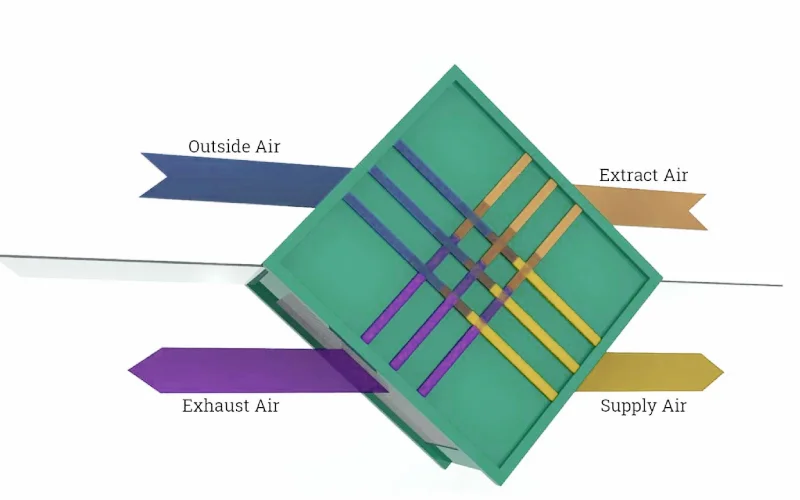
Plate Exchangers
Plate exchangers have thin metal plates stacked together. These plates make many small channels for air to move through. The big surface area helps heat move fast between the two air streams. The plates have a wavy shape that mixes the air and speeds up heat transfer. Plate exchangers are small and fit in tight spaces like on rooftops. They are simple to clean and work in factories and stores. Linkwell uses plate exchangers in many cooling systems because they work well and can be used in different ways.
Tube Exchangers
Tube exchangers use groups of tubes to move heat from one air stream to another. These exchangers work well in hard places. Many factories use them to save heat from exhaust air and warm up new air. Tube exchangers are found in car plants, dryers, ovens, and pollution control systems. They can handle dirty or rusty air because they use strong steel. Tube exchangers help with cooling, drying, and saving extra heat. Their tough build makes them great for big machines and factories.
Thermal Wheel
A thermal wheel is also called a rotary heat exchanger. It has a spinning wheel made from special stuff. The wheel goes through both warm and cool air. As it turns, it takes heat from the warm air and gives it to the cool air. This design can save up to 85% of the heat, and even more if it moves moisture too. The wheel has a big surface and lets air move easily, so it saves energy. Many buildings use thermal wheels to save power and make their air systems work better.
Run Around Coil
Run around coil systems have two coils joined by a loop with liquid inside. One coil is in the exhaust air, and the other is in the fresh air. The liquid carries heat from one coil to the other. This design works when the air streams are far apart. Run around coils do not let air mix, so they are safe for hospitals and labs. These systems save energy, make indoor air better, and need little care. Many big buildings and data centers use run around coils for cooling and heat recovery.
Energy Recovery Ventilators
Energy recovery ventilators, or ERVs, use a special core to move heat and moisture between outgoing and incoming air. This keeps indoor humidity steady, stops mold, and keeps people comfy. ERVs work well in places with lots of moisture or changing weather. They can save up to 80% of the energy from exhaust air. By controlling heat and moisture, ERVs lower HVAC energy use and make air cleaner. Linkwell adds ERVs to many air-to-air heat exchanger products to help save energy and work better.
Air-to-Air Heat Exchangers Applications
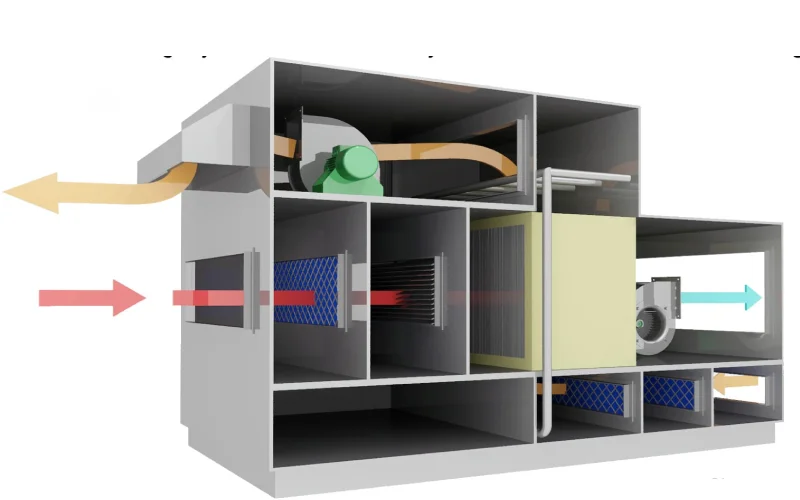
Electrical Enclosure Cooling
Air-to-air heat exchangers are important for cooling electrical enclosures. They help keep the temperature safe inside sealed cabinets. These cabinets protect sensitive electronics from harm. The system moves extra heat from inside to the outside air. The closed-loop design keeps out dust, water, and other bad things. This makes the system more reliable and uses less energy. It is used in control panels for factories, phone systems, and green energy. Many industries like these exchangers because they need little care and work well in tough places.
Air-to-air heat exchangers cool electrical enclosures without mixing air. This keeps equipment safe from getting too hot and helps it last longer.
Industrial and Commercial Use
Many industries use air-to-air heat exchangers for different jobs. They are found in car paint booths, wood drying rooms, and places that need dry air. These systems take heat from used air and warm up new air. This saves energy and lowers costs. Factories use them to control dust and fumes, making work safer. Offices, hospitals, and schools use them in hvac systems. They help meet air quality rules and cut down on energy use. These exchangers filter air and stop dirty air from mixing, which is good for places with pollution.
- Common industrial uses:
- Electrical control panels
- Making products
- Controlling pollution
- Air systems in buildings
Linkwell Outdoor Enclosure
Linkwell’s Outdoor Enclosure uses air-to-air heat exchangers to protect important systems. These cooling systems keep cabinets closed and block dust, water, and dirt. The heat recovery process moves heat out, keeping the inside cool. This helps factories, energy, and transport work better. Linkwell’s products are tested and last a long time. Their small size fits in tight spots, so they are good for phone stations, data centers, and factory machines.
Data Centers and Greenhouses
Data centers use air-to-air heat exchangers to cool equipment. These systems take away heat so machines do not get too hot. Cooling can use up to 40% of a data center’s power. Air-to-air heat exchangers help save energy and are better for the planet. They use indirect cooling, moving heat out without mixing air. Greenhouses also use these exchangers to control heat and water in the air. This helps plants grow better and saves energy. Both data centers and greenhouses use heat recovery to keep things working well and safe.
Benefits and Energy Efficiency
Cost Savings
Air-to-air heat exchangers help groups spend less on energy. Many schools and factories get their money back in under two years. One case showed a 400 hp air compressor saved $28,625 each year. A smaller 100 hp compressor still saved over $7,000 per year. These savings come from using less fuel and needing less heating or cooling. The table below shows how much energy and money can be saved with these systems:
| Metric | Value |
|---|---|
| AHU energy demand reduction | Up to 23.68% |
| First law efficiency improvement | 31.29% |
| Total exergy losses reduction | 26.58% |
| Second law efficiency improvement | 11.79% |
These numbers show that air-to-air heat exchangers lower energy bills and help systems work better.
Contaminant Control
Air-to-air heat exchangers keep indoor air clean by keeping the two air streams apart. This stops dust, fumes, and germs from moving between inside and outside air. Commercial buildings get better air because fresh air comes in without mixing with exhaust air. Lower CO2 and fewer health problems make these systems good for schools, offices, and hospitals. Cleaning filters often and having a good design keeps the air safe and healthy.
Maintenance Advantages
These systems need less care than regular hvac units. Filters and fans only need simple checks and cleaning. Most parts last a long time, so there is less downtime. When maintenance is easy, companies save money and keep equipment running well. This helps cooling and performance in many industries.
Linkwell Product Value
Linkwell’s air-to-air heat exchangers and outdoor enclosures meet strict UL, CE, and NEMA rules. These certifications show the products are safe and high quality. Linkwell products help customers use less energy and keep things working well. The company gives fast delivery, custom choices, and strong support. By picking Linkwell, businesses help the planet and protect their important equipment.
HVAC Comparison
Operation Differences
Air-to-air heat exchangers and traditional hvac systems work differently. Traditional hvac systems use separate units for heating and cooling. They often run furnaces and air conditioners at the same time. This happens in places with very hot or cold weather. Running both units costs more and uses more energy. Traditional hvac units do not recover heat from exhaust air. They must work harder to keep rooms comfortable.
Air-to-air heat exchangers recover heat from exhaust air. They preheat or precool incoming air. This lowers the work for heating and cooling units. The process saves energy and reduces costs. The two air streams stay separate, so air does not mix. Air-to-air heat exchangers have fewer moving parts. This means less maintenance and longer life.
Tip: Think about both the starting cost and future energy bills when picking hvac systems.
Efficiency and Air Quality
Traditional hvac systems use more energy because they do not reuse heat. This makes bills higher and repairs happen more often. These systems can also let bacteria and mold grow. Microbes can live in filters, ducts, and cooling coils. They spread through the air and can make people sick. Many buildings add extra cleaning tools, like UV lights or special filters, to help stop these problems.
Air-to-air heat exchangers save energy by recovering heat. They lower the need for extra heating or cooling. They keep intake and exhaust air apart, which helps control germs and dust. Some designs may let gases pass through, but most keep air streams separate. This helps keep indoor air clean and supports green goals.
Suitability for Applications
Air-to-air heat exchangers work best where saving energy and clean air matter. Factories use them to get heat from machines. Data centers use them to cool servers and reuse heat. Commercial buildings put them in ventilation systems to lower energy use. These exchangers fit well in places that need heat and moisture recovery.
Linkwell Outdoor Enclosures show how air-to-air heat exchangers can work better than regular hvac. In one biotech lab, switching to filter fans saved 28,000 kWh each year. A Texas data center kept steady temperatures and had no downtime after changing to fan-and-filter cooling. Many Linkwell sites saved between 36% and 76% energy, with payback in less than a year. These systems are reliable, with fewer failures and longer life.
Note: Air-to-air heat exchangers are best for places that need high energy savings, easy care, and strong control of germs and dust.
Air-to-air heat exchangers move heat without using extra power. They keep the two air streams apart. There are different types, like plate, tube, and wheel. These systems work well in factories and stores. They help use less energy for hvac and make the air cleaner. They also help lower pollution. Their tough design and safety labels mean they last a long time. Linkwell’s Outdoor Enclosure is a good way to protect equipment. Companies can ask Linkwell for help or special designs.
FAQ
What is the main job of an air-to-air heat exchanger?
An air-to-air heat exchanger moves heat between two air streams. It keeps the air streams apart. This saves energy and helps keep air clean.
How often should someone clean or replace the filters?
Most filters need cleaning every three months in clean places. In dusty spots, clean filters every month. Clean filters help the system work well and last longer.
Where do people use air-to-air heat exchangers most often?
People use these systems in factories and data centers. They are also used in greenhouses and electrical enclosures. These systems help control temperature and protect equipment.
What makes Linkwell’s Outdoor Enclosure special?
Linkwell’s Outdoor Enclosure keeps equipment safe from dust and water. It also protects from heat. The enclosure uses certified parts and comes in custom sizes. It works well in tough places and helps systems stay safe.
Conclusion
What is an Air to Air Heat Exchanger is key to improving energy efficiency, protecting equipment, and ensuring clean air. These systems transfer heat between two air streams without mixing, making them ideal for industrial, commercial, and HVAC applications.
Linkwell offers customized air-to-air heat exchanger solutions with fast delivery, strict quality certifications, and expert support—helping you save energy, reduce costs, and maintain system reliability.

